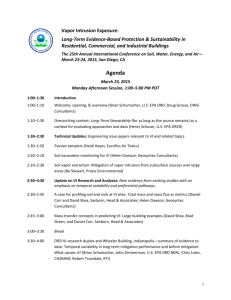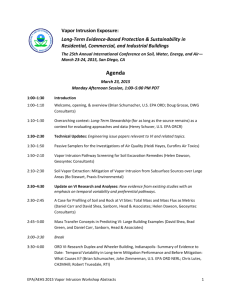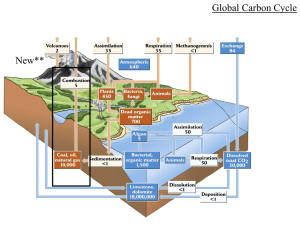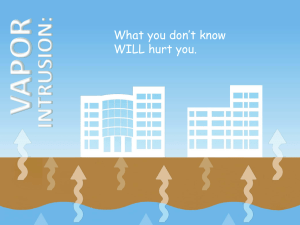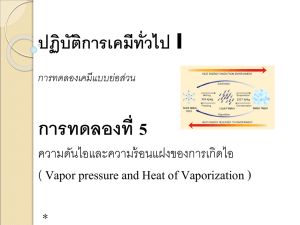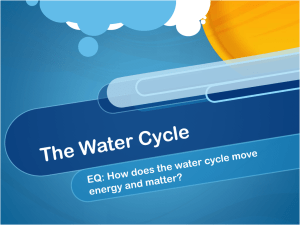Vapor Intrusion: When to Worry? NAREIM National Assn of Real
advertisement
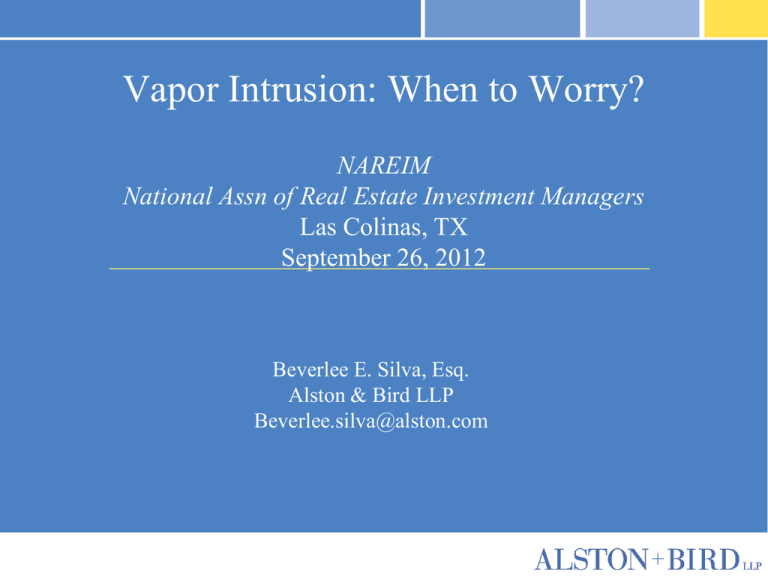
Vapor Intrusion: When to Worry? NAREIM National Assn of Real Estate Investment Managers Las Colinas, TX September 26, 2012 Beverlee E. Silva, Esq. Alston & Bird LLP Beverlee.silva@alston.com Why Should You Care? Human health concerns Can’t supply an alternative source of air Potential liability for personal injury Material impact on property value It is increasingly on the Regulators radar It is increasingly on Lender’s radar A Wake Up Call – Hillside School 1989 Current state of vapor intrusion law, regulation and guidance 32 states have developed / adopted VI guidance in the last few years More expected after EPA’s guidance is released Move towards including VI risk evaluations as part of standard Phase I ESA EPA is working toward a proposed rulemaking to add a new screening component to OSWER's Hazard Ranking System (HRS), which would allow sites impacted by vapor intrusion or intrusion of other subsurface contamination to be evaluated for placement on the Superfund National Priorities List (NPL). Newest Regulatory Developments EPA VI Guidance promised by November 30, 2012 ASTM – E2600-10 Examples of State Regulation California New York Numerous others (1,1-DCE and TCE have become the major COC) California DTSC (LA RWQCB) Soil Gas, Vapor Intrusion and Mitigation “Advisory” California Human Health Screening Levels EPA Region 9 Follows EPA Draft VI Guidance Adopted Region 3 Screening Levels Proposed DTSC Changes Preference for sub-slab samples Collect exterior soil gas samples at source Repeated sampling of soil gas Preference for gaseous tracers Raising sub-slab AF to 0.05 (5x stricter) A decision matrix? Defer to LUFT manual for petroleum hydrocarbons California LUFT Vapor Intrusion is NO PROBLEM if Dissolved GW concentrations < 1000 ug/L for benzene, and 10,000 ug/L for TPH and 5 feet from receptor Free product is 30 or more feet from receptor If above conditions are met, then it is assumed that natural attenuation is sufficient to mitigate concentrations New York In 2005 NY reopened over 400 pollution cases to determine if chemical vapors were lingering at the sites Over 250 of those cases are now listed as completed Current law went into effect in 2008 Requires notice to be given to tenants when owner or owner’s agent receives a letter from “issuer” that test results exceed NYSDOH guideline or an OSHA guideline Issuers include: New York State DEC Certain Municipalities Person subject to an order under State Superfund or Oil Spill Program Participant entered into a Brownfield Site Cleanup Agreement Fact Sheets The owner must submit one or more fact sheets from NYSDOH within 15 days of receipt of SVI results which exceed relevant guideline, identify: Compound or contaminant of concern Detected levels of the compound or contaminant Health risks associated with exposure to compound or contaminant A means of obtaining additional info on the compound or contaminants If subject to engineering control, owner must provide fact sheet to prospective tenant prior to signing of lease Lease must include the following language in bold: “NOTIFICATION OF TEST RESULTS: The property has been tested for contamination of indoor air: test results and additional information are available upon request." New York Upcoming Legislation Proposed Law to Be Introduced Next Year Amends Current VI Law Strengthen current requirements for notifying tenants of health risks at contaminated sites Amend current notification requirements to include subtenants Require warning signs on contaminated buildings Double the maximum fine landlords face for violating law Due Diligence for Vapor Intrusion Start with general questions Type of contaminants On-site/offsite From owner, former owner, or third party Remediation status Closed Ongoing investigation/remediation Remediation strategy Active/passive Planned use Engineering controls AAI may or may not include ASTM E 2600-10, but recommended in due diligence Lender Requirements for Vapor Intrusion Current state of lender requirements CERCLA – secured creditor exemption Requires: No affiliation with polluter Disposal ended before purchase of site All Appropriate Inquiry (AAI) performed before purchase Report any releases identified Continuing obligations after purchase Likely direction for lender requirements VI required as part of Phase I ESA ASTM E 2600-10 Adopted June 14, 2010: “Standard Guide for Vapor Encroachment Screening on Property Involved in Real Estate Transactions.” Replaced 2008 “Standard Practice for Assessment of Vapor Intrusion into Structures on Property Involved in Real Estate Transactions” The revised standard is refocused solely on screening for the likelihood of volatile vapors to reach the subsurface of a property involved in a or otherwise real estate transaction --a Vapor Encroachment Condition (VEC). Acronyms VES: Vapor Encroachment Screen Chemicals of Concern (COC): Chemical that can potentially migrate as a vapor into a structure, and is generally recognized as having an adverse impact on human health. COC generally meet specific criteria for volatility and toxicity. Vapor Encroachment Condition (VEC): The presence or likely presence of any chemicals of concern in the indoor air environment of existing or planned structures on a property caused by the release of vapor from contaminated soil or groundwater on the property or within close proximity to the property, at a concentration that presents or may present unacceptable health risk to occupants. PVEC – Potential VEC Two Tier Vapor Encroachment Screen Tier 1 – Investigation of all known or suspected contamination within Area of Concern Tier 2 – Screening to determine actual risk Tier 1 Tier 1 of a VES is an investigation of all known or suspected contaminated properties within an Area of Concern AOC for petroleum contamination -- 1/10 of a mile AOC for VOCs -- 1/3 of a mile Tier 1 May include: searches of government records, local history, media archives and aerial photography Does PVEC exist within area of concern? May need to move on to Tier 2 screening Professional judgment of EP crucial Tier 2 May include physical sampling of soil and groundwater to determine the nature and extent of the underground plume If sufficient information exists in regulatory records or previous investigations, physical sampling may not be necessary Tier 2 Three questions: how serious is the contamination? how close is it to the property of interest? it likely to encroach on the property? Crucial questions to evaluating whether to invest/lend What Affects Vapor Intrusion? Contaminant Type (i.e., petroleum compounds or chlorinated solvents) Type of soil under the structure, Contaminant concentration, Exposure/contaminant migration pathways (i.e., foundation cracks, utility trenches), Depth and location of contaminants relative to the structure, and building/ventilation system design. How Does ASTM E2600-10 Impact Diligence? Contains legal appendix to clarify the relationship with the ASTM E 1527-05 Phase I standard, CERCLA, and AAI. EPA appears to agree with ASTM interpretations Phase I The Legal Appendix of E 2600-10 “clarified” that vapor migration onto a property involved in a real estate transaction needs to be evaluated in a Phase I investigation, no different than groundwater migration. If VEC is found to exist or is likely, then EP uses professional judgment to determine if VEC represents a recognized environmental condition (REC). AAI CERCLA, the definition of “release” includes the terms “emitting” and “escaping” into the “environment” In the AAI rule, the environmental professional is required to provide “an opinion as to whether the inquiry has identified conditions indicative of releases or threatened releases of hazardous substances…on, at, in, or to the subject property.” VEC is a “release” under CERCLA and for purposes of AAI When to Worry? Location Structures with odors, wet basements, floors Sites with contamination (future use restrictions) Complaining occupants Be particularly sensitive to VI issues on properties on or near residential developments or sensitive-use operations (e.g., day cares or schools) Higher risk of lawsuits Different standard of care with sensitive populations What types of site cause most worry? Brownfields Redevelopment Former industrial site with on-site soil and groundwater impacts Purchase of commercial property Former dry cleaner or gas station on-site or nearby Petroleum Hydrocarbons Service Stations, USTs, Pipelines Oil Furnaces (naphthalene) Chlorinated Hydrocarbons Vapor Degreasers (TCE, TCA) Dry Cleaners (PCE, DCE) Circuit Boards (VC, TCE, CCl4) Semi-Volatiles MGP Sites (PAHs) Electrical Power (PCBs) How to Protect Yourself? Environmental insurance Mitigation techniques Revise environmental due diligence policies or Phase I scopes of work to address vapor intrusion When reviewing Phase I ESA, look beyond list of recognized environmental conditions (RECs) Mitigation v. Liability Institutional controls Engineering controls = removal of the contamination sources placement of vapor barriers vapor collection systems indoor treatment systems Not legally enforceable Intrinsically safe building design = building features as ventilated basements, vapor barriers and other systems to reduce or eliminate vapor intrusion issues Mitigation techniques at site and jurisdiction specific
